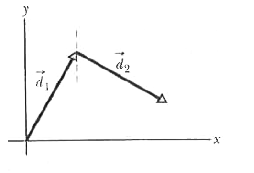If →d1+→d2=5→d3,d1−d2=3d3,and→d3=2ˆi+4ˆj, then what are , in unit-vector notation,(a) →d1and(b)→d2 ?
To solve the problem, we will follow these steps:
Given:
1. →d1+→d2=5→d3 (Equation 1)
2. →d1−→d2=3→d3 (Equation 2)
3. →d3=2^i+4^j
Step 1: Substitute →d3 into Equations 1 and 2
We can substitute →d3 into both equations to express them in terms of →d1 and →d2.
From Equation 1:
→d1+→d2=5(2^i+4^j)=10^i+20^j
From Equation 2:
→d1−→d2=3(2^i+4^j)=6^i+12^j
Step 2: Set up the equations
Now we have two equations:
1. →d1+→d2=10^i+20^j (Equation 3)
2. →d1−→d2=6^i+12^j (Equation 4)
Step 3: Add Equations 3 and 4
To eliminate →d2, we can add the two equations:
(→d1+→d2)+(→d1−→d2)=(10^i+20^j)+(6^i+12^j)
This simplifies to:
2→d1=(10+6)^i+(20+12)^j=16^i+32^j
Now, divide by 2:
→d1=8^i+16^j
Step 4: Substitute →d1 back to find →d2
Now, substitute →d1 back into Equation 3 to find →d2:
8^i+16^j+→d2=10^i+20^j
Rearranging gives:
→d2=(10^i+20^j)−(8^i+16^j)=(10−8)^i+(20−16)^j=2^i+4^j
Final Answers:
(a) →d1=8^i+16^j
(b) →d2=2^i+4^j
---
1. →d1+→d2=5→d3 (Equation 1)
2. →d1−→d2=3→d3 (Equation 2)
3. →d3=2^i+4^j
We can substitute →d3 into both equations to express them in terms of →d1 and →d2.
→d1+→d2=5(2^i+4^j)=10^i+20^j
From Equation 2:
→d1−→d2=3(2^i+4^j)=6^i+12^j
Now we have two equations:
1. →d1+→d2=10^i+20^j (Equation 3)
2. →d1−→d2=6^i+12^j (Equation 4)
To eliminate →d2, we can add the two equations:
(→d1+→d2)+(→d1−→d2)=(10^i+20^j)+(6^i+12^j)
This simplifies to:
2→d1=(10+6)^i+(20+12)^j=16^i+32^j
Now, divide by 2:
→d1=8^i+16^j
Now, substitute →d1 back into Equation 3 to find →d2:
8^i+16^j+→d2=10^i+20^j
Rearranging gives:
→d2=(10^i+20^j)−(8^i+16^j)=(10−8)^i+(20−16)^j=2^i+4^j
(a) →d1=8^i+16^j
Topper's Solved these Questions
- BOOK - RESNICK AND HALLIDAYCHAPTER - VECTORS EXERCISE - PRACTICE QUESTIONS39videos
VECTORS
- BOOK - RESNICK AND HALLIDAYCHAPTER - VECTORS EXERCISE - CHECKPOINT5videos
VECTORS
- BOOK - RESNICK AND HALLIDAYCHAPTER - UNITS AND MEASUREMENT EXERCISE - PRACTICE QUESTIONS (MATRIX-MATCH)11videos
UNITS AND MEASUREMENT
- BOOK - RESNICK AND HALLIDAYCHAPTER - WAVE - IIEXERCISE - PRACTICE QUESTIONS (INTEGER TYPE)5videos
WAVE - II
Similar Questions
(a) In the figure here, what are the signs of the x components of →d1and→d2 ? (b) What are the signs of the y components of →d1and→d2 ? (c ) What are the signs of the x and y components of →d1+→d2 ?
 View Solution
View SolutionDisplacement →d1 is in the yz plane 63.0∘ from the positive direction of the y axis, has a positive z component , and has a magnitude of 4. 80 m. Displacement →d2 is in the xz plane 30.0∘ from the positive direction of the x axis, has a positive z component, and has magnitude 1.40m. What are (a) →d1.→d2, (b)→d1x→d1,and (c ) the angle between →d1and→d2 ?
View Solution
Knowledge Check
- Question 1 - Select One
If →a,→b,→cand→d are unit vectors such that (→a×→b).(→c×→d)=1and→a.→c=12 then (A) →a,→b,→c are non coplanar (B) →b,→c,→d are non coplanar (C) →b,→d are non paralel (D) →a,→d are paralel and →b,→c are parallel
Aˆa,ˆb,ˆc are non-coplanarBˆb,ˆc,ˆd are non-coplanarCˆb,ˆd are non-parallelDˆa,ˆd are parallel and ˆb,ˆc are parallel - Question 2 - Select One
Each of two vectors →D1and→D2 lies along a coordinamte axis in the x-y plane. Each vector has its tail at the origin, and the dot product of the two vectors is →D1,→D2=−∣∣→D1∣∣.∣∣→D2∣∣ Which is possiblility is correct ?
A→D1and→D2 both lie along the positive x-axis.B→D1 lies along the positive x-axis →D2 lies along the negative x-axis.C→D1and→D2 both lie along the positive y-axis.D→D1 lies along the negative x-axis →D2 lies along the negative y-axis. - Question 3 - Select One
→a,→band→c are unimdular and coplanar. A unit vector →d is perpendicualt to them , (→a×→b)×(→c×→d)=16ˆi−13ˆj+13ˆk , and the angle between →aand→bis30∘ then →c is
A(ˆi−2ˆj+2ˆk)/3B(−ˆi+2ˆj−2ˆk)/3C(−ˆi+2ˆj−ˆk)/3D(−2ˆi−2ˆj+ˆk)/3
Let →a=4ˆi+5ˆj−ˆk,→b=ˆi−4ˆj+5ˆkand→c=3ˆi+ˆj−ˆk. Find a vector →d which is perpendicular to both →aand→b and satisfying →d.→c=21
View SolutionThere vectors →a,→b and →c each have a magnitude of 50 m and lie in an xy plane. Their directions relative to the positive direction of the x axis are 30∘,195∘,and315∘, respectively. What are (a) the magnitude and (b) the angle of the vector →a+→b+→c, and (c ) the magnitude and (d) the angle of →a−→b−→c ? What are the (e) magnitude and (f) angle of a fourth vector →d such that (→a+→b)−(→c+→d)=0 ?
View Solution36. If →a,→b,→cand→d are unit vectors such that (→a×→b).→c×→d=1 and →a.→c=12 then a) →a,→band→c are non-coplanar b) →b,→c,→d are non -coplanar c)→b,→d are non parallel d) →a,→d are parallel and →b,→c are parallel
View SolutionIf ¯a=3ˆi−ˆj+ˆk,→b=2ˆi−3ˆj−ˆk,→c and →d=2ˆj+ˆk, then the value of →d.(→a×→b×(→c×→d)) equals
View SolutionGiven a+b+cd+c=0 , which of the following statements are correct?
(a) →a,→b,→cand→d must each be a null vector .
(b) The magnitude of (→a+→c) equals the magnitude of (b+d)
(c) The magnitude of →a can never be greater than the sum of the magnitudes of →b,→cand→c.
(d) →b+→c must lie in the plane of →aand→d if →aand→d are not collinear ,and in the line of →aand→d, if they are collinear.View Solution

